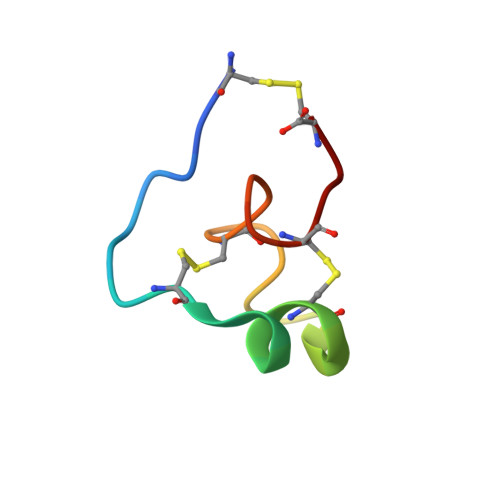Structure, folding and stability of a minimal homologue from Anemonia sulcata of the sea anemone potassium channel blocker ShK.
Krishnarjuna, B., MacRaild, C.A., Sunanda, P., Morales, R.A.V., Peigneur, S., Macrander, J., Yu, H.H., Daly, M., Raghothama, S., Dhawan, V., Chauhan, S., Tytgat, J., Pennington, M.W., Norton, R.S.(2018) Peptides 99: 169-178
- PubMed: 28993277
- DOI: https://doi.org/10.1016/j.peptides.2017.10.001
- Primary Citation of Related Structures:
5WCV - PubMed Abstract:
Peptide toxins elaborated by sea anemones target various ion-channel sub-types. Recent transcriptomic studies of sea anemones have identified several novel candidate peptides, some of which have cysteine frameworks identical to those of previously reported sequences. One such peptide is AsK132958, which was identified in a transcriptomic study of Anemonia sulcata and has a cysteine framework similar to that of ShK from Stichodactyla helianthus, but is six amino acid residues shorter. We have determined the solution structure of this novel peptide using NMR spectroscopy. The disulfide connectivities and structural scaffold of AsK132958 are very similar to those of ShK but the structure is more constrained. Toxicity assays were performed using grass shrimp (Palaemonetes sp) and Artemia nauplii, and patch-clamp electrophysiology assays were performed to assess the activity of AsK132958 against a range of voltage-gated potassium (K V ) channels. AsK132958 showed no activity against grass shrimp, Artemia nauplii, or any of the K V channels tested, owing partly to the absence of a functional Lys-Tyr dyad. Three AsK132958 analogues, each containing a Tyr in the vicinity of Lys19, were therefore generated in an effort to restore binding, but none showed activity against any of K V channels tested. However, AsK132958 and its analogues are less susceptible to proteolysis than that of ShK. Our structure suggests that Lys19, which might be expected to occupy the pore of the channel, is not sufficiently accessible for binding, and therefore that AsK132958 must have a distinct functional role that does not involve K V channels.
Organizational Affiliation:
Medicinal Chemistry, Monash Institute of Pharmaceutical Sciences, Monash University, 381 Royal Parade, Parkville, VIC 3052, Australia.














